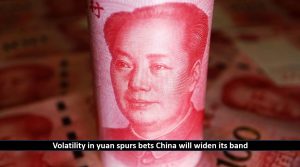Volatility in yuan spurs bets China will widen its band

As macroeconomic risks induce unprecedented levels of volatility in China’s yuan, investors are betting that authorities may widen the currency’s tight trading band for first time since 2014 to allow market forces greater say.
China’s yuan is allowed to move in a narrow range of 2% against the U.S. dollar, around a daily official midpoint fixing set by the People’s Bank of China (PBOC).
In the 8 years since the band was defined, the currency has rarely ever moved beyond 1% on either side of the mid-point.
It lost its languor in September as an aggressive Federal Reserve and robust dollar pushed the yuan to the weaker side of 7 versus the greenback, foreign capital fled an economy struggling under regulatory and COVID-19 crackdowns, and the PBOC seemed okay letting market forces decide where the yuan should be.
“We see a possibility of the PBOC widening the yuan’s daily trading band against the dollar to 3% from 2% in 2023, given greater tolerance of increased market volatility,” said Becky Liu, head of China macro strategy at Standard Chartered (OTC:SCBFF) Bank.
Day-to-day yuan volatility has been as high as 16% on some days in October, compared with a tame 1% to 4% range in the months and years before. The currency came close to touching the weak end of the band in five out of 16 trading days in October.
Implied volatility, an options market gauge of future volatility, has spiked. An options trader said the market was “long volatility”.
One-, 3- and 6-month,, yuan implied volatility have hit all-time highs, while 9-month and one-year tenors are at their loftiest levels since Beijing’s currency reforms in 2015 when it engineered a sharp one-off 2% devaluation.
Important Note: The information found on Ausprime platform is intended only to be informative, is not advice nor a recommendation, nor research, or a record of our trading prices, or an offer of, or solicitation for a transaction in any financial instrument and thus should not be treated as such. The information provided does not include any specific investment objectives, financial situation and needs of any specific person who may receive it. The past performance is not a reliable indicator of future performance and/or results. Past Performance or Forward-looking scenarios are not a guarantee of future performance. Actual results may differ materially from those anticipated in forward-looking or past performance statement